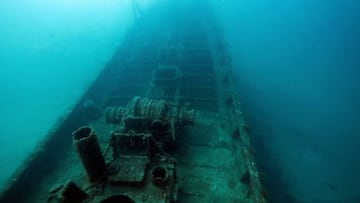Did the Titanic sink intact?
An official US investigation stated that the Titanic sank intact. After a great debate for 73 years, it was finally found split in two on the ocean bed.

On April 10, 1912, the Titanic set sail from Southampton- the largest ocean liner ever built, which began its maiden voyage to New York with more than 2,500 people on board between crew and passengers. On the night of April 14, the ship struck an iceberg which tore the bottom of the hull, causing a flood that culminated in its sinking and the deaths of more than 1,500 people.
The captain of the Titanic, Edward Smith, knew the navigation route perfectly well and on that occasion he opted for a more conservative option to sail further south than usual to avoid icebergs. However, according to the conclusions of the multitude of investigations surrounding the famous accident, the ocean liner went down due to a chain of human errors.
Did the Titanic sink intact?
When it collided with the large iceberg, the ship was traveling at 23 mph or 20.5 knots per hour. In less than three hours later, the 880-foot-long Titanic sank. There were at least 15 witnesses who swore on record that they had seen the ship break into two parts before completely sinking beneath the waves, but they were ignored.
An official US investigation stated that the ship sank intact. How it sank was debated for 73 years until the ship was finally found at the bottom of the ocean, broken in two. The wreck still helps today in improving protocols in construction and ship safety.
The Titanic wreck: a tourist attraction
The discovery of the Titanic in 1985 was the result of a secret investigation by the US Navy to search for two sunken nuclear submarines. The remains were discovered by Robert Ballard and, after the find, several expeditions took place in the area for research and artifact recovery.
The tragedy has attracted the attention of millions of people over the years. The ship’s remains have become a tourist attraction operated by companies such as OceanGate, which offered seats in mini deep sea vessels like the Titan to the very rich for $250,000 to visit the wreck.
The Titan tragedy
Despite the advances in ocean exploration, expeditions are not without risks. Five people lost their lives due to the catastrophic implosion of the Titan submersible while on a tourist trip to the wreck of the Titanic. In the vessel were British millionaire Hamish Harding, 58 years old, president of the company Action Aviation; Pakistani Shahzada Dawood, 48, vice president of Engro, and his son Suleman, 19, both also British nationals; French expert diver Paul-Henri Nargeolet, 77 years old; and Stockton Rush, CEO of OceanGate Expeditions.
They all signed a contract of risk, which on the first page mentioned death up to three times. They also signed a clause in which they exempted the company organizing the trip from any responsibility in the event of an accident.
Deterioration of the remains of the Titanic
It appears the famous wreck will not be around for too long. The Titanic is suffering serious deterioration caused by the corrosion of salt and bacteria that consume metal, according to Caladan Oceani, the company that supervises expeditions to the liner. There are parts that have completely disappeared and what remains continues to be devoured by bacteria.





